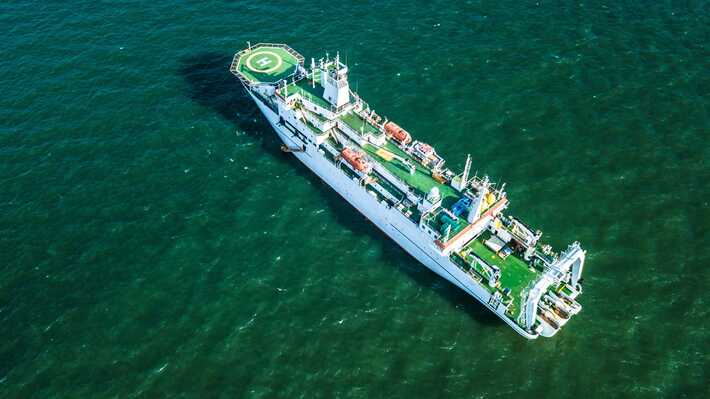The Infrastructure of The Internet: The Submarine Cables
Reading time: 7 min |
06 January 2022

Did you know that 95% of the world's data traffic travels through the oceans?
Most of our daily communication travels through submarine cables, but a video call doesn't go through a specific cable to reach its destination, it's actually a branching infrastructure made up of many different networks and servers.
This means that data can travel halfway around the globe from sender to receiver in milliseconds.
We've put together the most interesting facts about the internet infrastructure.
Read the full article at your leisure or jump directly to a category that interests you:
1. We Humans Affect Submarine Cables.
2. Laying Submarine Cables.
3. Interactive Map of Submarine Cables.
4. Submarine Cables as a New Attack Surface.
5. What Does the Future Hold?
6. Data and Climate
Try leitzcloud now
See for yourself!
Create a trial account easily!
No payment information required.
Start Free Trial
1. We Humans Affect Submarine Cables.
The constant drive for new technological developments by humans influences the development of undersea cables.
In 1851, the first undersea cable was laid between Dover and Cap Gris-Nez.
This laying was essential and a great success for economic development.
By laying the telegraph cable, a telephone connection between France and England was now established.
This innovation eventually achieved a new goal: Transatlantic undersea cables, which connect Europe with America.
In 1988, the first transatlantic fiber optic cable named TAT8 was laid between the United States, France, and Britain.
With the continuous growth of the infrastructure, a better construction method was developed.

2. Laying Submarine Cables.
Specialized vehicles are used to bury the submarine cables in the seafloor.
There are two different methods of installation, depending on the seabed.
If it is sandy, the cable is pressed into the ground, creating a trench in which the cable is embedded.
In the second method, a cable plow is used to open up the seafloor and lay the cable.
The cables are brought ashore through a duct at the beach.
Global nodes include Marseille, New York, Singapore, and the United Arab Emirates.

3. Interactive Map: Submarine Cables
4. Submarine Cables as a New Attack Surface.
Submarine cables can be seen as a new attack surface not only from a geopolitical perspective. Currently, the US and the People's Republic of China are in competition in building submarine cables.
In addition to China's biggest foreign policy project, the construction of the new Silk Road, China also wants to participate in the expansion of submarine cables.
In Marseille, the People's Republic of China is building the submarine cable "Peace". The 12,000 km-long cable is intended to connect China with Europe via the Horn of Africa and Pakistan.
Critics fear that China is building and financing the submarine cable to eavesdrop on data of European citizens.
This would not be a new phenomenon. In 2013, former CIA agent Edward Snowden revealed that the US had been eavesdropping on the data of governments and millions of people for years by tapping into the submarine cables.
However, submarine cables can also be damaged by natural disasters or by boat anchors and towed nets.
However, this does not necessarily mean an internet outage, as the data usually arrives at the destination via other routes.

5. What does the future hold?
Traditional telecommunications companies are no longer investing in the construction of submarine cables. They have been replaced by US companies such as Google, Microsoft, and Facebook, who are increasingly participating in the market, but also Chinese companies such as Huawei are getting more involved in the construction of submarine cables. A growing privatization of the provision of this infrastructure is becoming apparent, which also means an increasing dependence of Europe on the US and China.
6. Data and the Climate
The fact that data is always available doesn't come without consequences... Data is a real environmental offender.
In 2019, French researchers found that data is responsible for a large portion of global CO2 emissions.
Streaming services like Netflix are particularly under scrutiny.
However, the data center you use makes a big difference.
Your data is stored climate-neutral in the German data center Maincubes in Frankfurt.
This is a data center that uses 100% renewable energy and thus consumes 60-80% less CO2. Your data is excellently protected by the highest security standards.
Test leitzcloud as a Secure Cloud Solution Now
Secure your data in a securely encrypted cloud with a sustainable data center in Germany.
Store data securely now
The highest
safety standards
Your data is stored in the sustainable data centre in Frankfurt with state-of-the-art security. Such as biometric access control, armoured walls, perimeter sensing BMS system, CCTB and motion detection.
DE-CIX
The DE-CIX internet hub in Frankfurt is one of the busiest exchange points in the world in terms of data volume.
Identity control
No one is allowed to enter or leave the data centre just like that. Everyone has to register and identify themselves before they are allowed to enter.
Secured 24/7
The heavily secured leitzcloud servers are continuously monitored by our technical department. If there is a problem, we are the first to know and will fix it immediately!
No bandwidth restriction
To ensure you don't have to wait long for an upload or download, we use super-fast internet. We don't limit the bandwidth for anyone!
Sources:
bdew: In deep solidarity: submarine cables for the energy transition. (accessed 20.01.2022)
Handelsblatt: Wired or tied up? The power struggle over data cables in the sea. (accessed 20.01.2022)
Arte: With your cards on the table - Submarine cables - The invisible war (accessed 20.01.2022)
Tagblatt: Deep-sea cables are still in operation today: one pair of pliers is enough to paralyse data traffic (accessed 20.01.2022)
